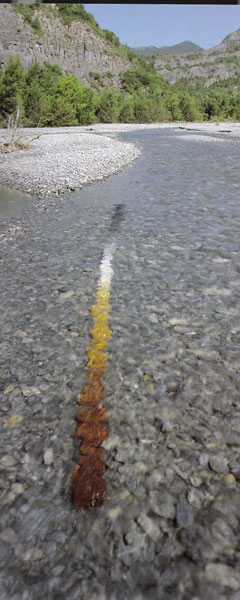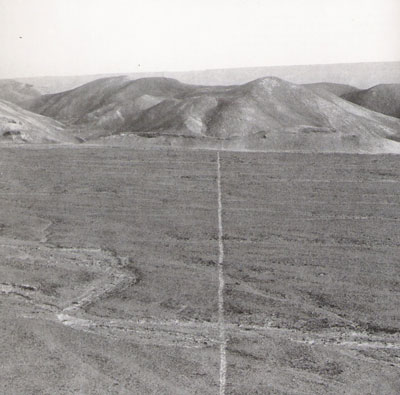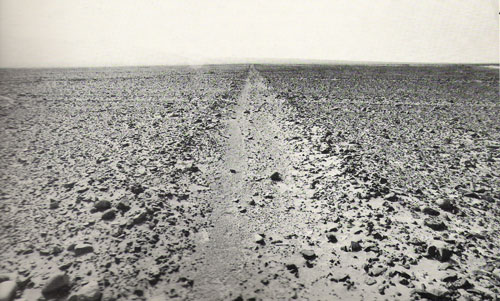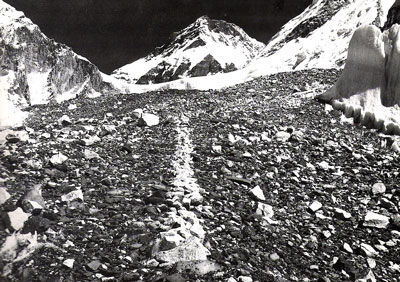Art 308: Sculpture Studio
Monica Milstead
Project 3- Site / Place
ARTIST RESEARCH
Site-specific sculpture that takes on real places, as opposed to imagined or remembered places, has to deal with the issues embedded in the context of working within an already established location or space. Be it a building, like a gallery, which an artist is working within, or a desert—the space or environment already has an existing structure, or an even an existing feeling to it that exists without any artist’s hand adjusting it.
Earthworks move outside of the gallery space and attempt to take on or engage with the physical conditions of the site that the artist has chosen or decided to respond to. Works can employ the landscape as material, or respond to the landscape as a space, and sometimes treads the line between these two distinctions. They must also bend to the greater will of nature whose forces often destroy earthworks over time.
Andy Goldsworthy is a British artist who turns to the landscape and treats it as a large studio—keeping to the materials provided at each site. His palette is provided by nature. While painting looks at a color and tries to recreate that with pigments from a tube, Goldsworthy uses the colors he finds in the site he is working at—as much as he is using stones, ice, and even tools found at the location. His work isn’t garish, and it doesn’t seem dislocated from its surroundings because of this. He also engages with the aspect of time in his work—not only the ephemeral nature of his work, but the sense that “the moment of my working a material and of my being there was bound up with what had gone before.” His work is not just confined to what he does—but what has happened before he has come to the field or beach: who has been there before him, animals or people, what the weather has been like, what season it is, et cetera. The stones that he might choose to work with at a streambed had to have been deposited at an earlier time by the force of the moving water. Or, time and the elements of nature may have taken away some material that he may have come upon if he had arrived months or even days earlier. As Goldsworthy writes in a letter in 1983, “a rock is not independent of its surroundings. The way it sits tells how it came to be there. The energy and space around a rock is as important as the energy and space within.”
Often, Goldsworthy will return to previously worked sites and note the differences that occurred in his absence. Upon his return to Digne-les-Bains, in France, he arrives to find a “very different river to the one I worked with several years ago. The place appears the same, but the river has changed colour and direction, leaving dried-up hollows and channels where it once flowed and formed pools. I don’t remember the water ever running clear—at its clearest it’s milky and at its murkiest thick black…” He notes these differences, and in this untitled colored rock piece he works within the changes of nature—using the clear water and streambed as a canvas and space to work with.

Digne-les-Bains, Haute Provence, France—8 July 1998
Goldsworthy’s approach to process is both a sculptural one and a photographic one. It is only through his photographs of his work that we can experience the work he creates—in books or posters, or maybe in galleries. It is doubtful that anyone else except those that Goldsworthy allows ever encounter his smaller works in person. The photographs themselves function as much more than a documentation of an earthwork. They capture what he has created, yes, but the quality of the photograph creates a tension between the ephemeral nature of the actual work and the “document” of that work. The preservation of his private moments in the form of photograph could run against or obscure the true nature of other earthwork artist’s work—but Goldsworthy’s photographs capture the “immaculacy of his efforts.” Rather than obscuring the nature of his work, his photographs are revealing. First, we are provided this image of a spectrum of colored stones running through the water in the line. We must realize that there is no longer that line in the stream in France, it probably was destroyed during or shortly after Goldsworthy’s stay there. But this lends a preciousness to the photograph he has created of the work—the only documentation of his hand in the space, besides his writing about it. It is a stunning image, because it is not overwhelming. It accompanies the subtlety of Goldsworthy’s work—it does not boastfully show what he has created, it shows it within the space.
Furthering the humble nature of the sculptures is Goldsworthy’s documentation of the destruction of some of his sculptures. Destruction may be a strong word—but the elements of nature deconstruct (slowly or quickly) the sculptures he creates.

Carrick Bay, Dumfriesshire October 1999
This work was created by wrapping wet feathers around a stone and placing it before the incoming tide. Goldsworthy creates a piece that acquiesces to the forces of the water. He does not try to create something that will outlast nature.
Another artist who uses only the elements provided in his space is yet another British earthworks artist, Richard Long. However, Long doesn’t just use the landscape as a material, he is engaging it as a space as well. “His circles in the landscape seem more like enclosures than forms, his lines are indications of direction.”
While Andy Goldsworthy’s works are more sculptural in their existence (in that they exist as objects, albeit for a short time), Long’s works are more space defining than Goldsworthy’s. His walking or rambling lines that he began in the late 1960s, record a sense of human history or direction naturally. It is natural because it is the space that he has traveled with his own body, and he is referencing or even working on top of previous histories, dealing with the cultural history of walking . His piece Walking a Line in Peru, is worked on top of the numerous line drawings made by the Nazca culture between 800 and 300 B.C. It is already a path that has lasted for over two thousand years, and Long also contributes to this cultural history that is embedded in the landscape.
 |
 |
Walking a Line in Peru 1972 |
Line Drawings from Naza Culture- 800-300 B.C. |
Another piece, Walking a Line in the Himalayas, doesn’t necessarily cover already created paths—but it does dialogue with the idea of mankind’s need to migrate and scale earth’s obstacles in their way. Perhaps the line that Long walks and records with white stones from the actual site has been walked before by others, in the near or distant past.

Walking a Line in the Himalayas 1989
Richard Long’s work is more insistent than Andy Goldsworthy’s, but is still just as humble. The existence of man is more undeniable here because these lines don’t easily blow away or get taken by the tide. His works often engage roadways , paths already established, but furthered by Long. Goldsworthy’s work may be about time and the rapid changes that occur in nature’s time, but Long’s work is more about man’s time spent within the landscape, and establishing a record of that.
St. Mary's College of Maryland
St. Mary's City MD 20686-3001
Back to Index
This page was last updated: April 7, 2008 3:22 PM